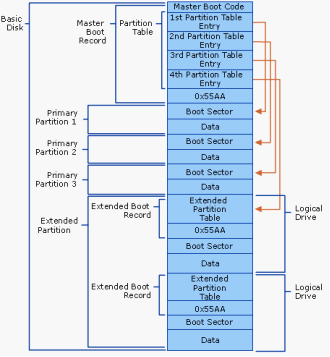Introduction to basic disk
Primary partitions, extended partitions and logical drives are applied to organize data in basic disk. The formatted partition is also called volume (the terms"volume" and "partition" can be exchanged for use). In this Windows edition, the basic disk contains 4 primary partitions or 3 primary partitions and an extended partition that may contain many logical drives. Partitions in basic disk can not split data or be shared with other partitions. Every partition in basic disk is an independent entity of the disk.
Basic disk is a physical disk containing primary partitions, extended partitions or logical drives. Partitions and logical drives are called basic volumes. And basic volumes can only be built in basic disk.
Partition Forms
The number of partitions built in basic disk depends on partition forms of disk.
7. Up to 4 primary partitions or 3 primary partitions with an extended partition can be created in MBR disk. And several logical drives can be built in extended partition.
8. Up to 128 primary partitions can be created in GUID (GPT) disk. As GPT disk is not limited to 4 partitions, extended partitions or logical drives are not necessary.
More space can be added to present primary partitions and logical drives. And it can be realized by extending the original primary partitions and logical drives to the nearby continuous unallocated space. If basic volumes need to extend, they must be formatted by NTFS file system. Logical drives can be expanded in the extended partition containing continuous available space. If the size of logical drives needing to extend exceeds the available space in extended partition, the extended partition will expand to contain logical drives only if there is enough continuous unallocated space.
Operating Environment
 Basic disk instead of dynamic disk is always applied in computer running S-DOS, Windows 95, Windows 98, Windows Millennium Edition, Windows NT 4.0 or Windows XP Home Edition, and these systems must be configurated through Windows XP Professional or Windows Server 2003 to realize double leading system. However, these systems can not access data stored in dynamic disk.
Basic disk instead of dynamic disk is always applied in computer running S-DOS, Windows 95, Windows 98, Windows Millennium Edition, Windows NT 4.0 or Windows XP Home Edition, and these systems must be configurated through Windows XP Professional or Windows Server 2003 to realize double leading system. However, these systems can not access data stored in dynamic disk.The multiple disk basic volumes (such as volume set, mirror set, stripe set and stripe set of parity) created in Windows NT4.0 or earlier edition are not supported by operating systems of Windows Windows XP Professional and Windows Server 2003. The disk partition magic MiniTool Partition Wizard is in support of partition operation and management of volume set, mirror set, stripe set and stripe set of parity.
